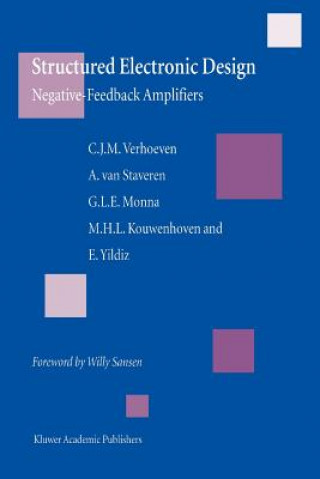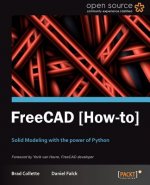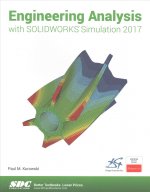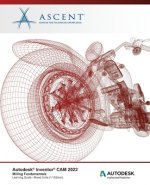
Kód: 01423681
Structured Electronic Design
Autor Chris J.M. Verhoeven, Arie van Staveren, G.L.E. Monna, M.H.L. Kouwenhoven
Analog design is one of the more difficult aspects of electrical engineering. The main reason is the apparently vague decisions an experienced designer makes in optimizing his circuit. To enable fresh designers, like students elec ... celý popis
- Jazyk:
 Angličtina
Angličtina - Vazba: Brožovaná
- Počet stran: 380
Nakladatelství: Springer, Berlin, 2010
- Více informací o knize

4798 Kč

Skladem u dodavatele v malém množství
Odesíláme za 12-15 dnů
Potřebujete více kusů?Máte-li zájem o více kusů, prověřte, prosím, nejprve dostupnost titulu na naši zákaznické podpoře.
Přidat mezi přání
Mohlo by se vám také líbit
-

Polymer Nanoclay Composites
3516 Kč -

History of Rasselas, Prince of Abissinia
276 Kč -

Rationalism of Georg Lukacs
1681 Kč -

Fall and Rise of China
716 Kč -

Worlds of Carol Shields
1081 Kč -

Nerve
283 Kč -

Cooking Apicius
413 Kč -

Halo
276 Kč -

Oxford Handbook of Post-Keynesian Economics, Volume 2
6104 Kč -

How to Make a Treadle-Operated Wood-Turning Lathe
530 Kč -

Plato's Ethics
2531 Kč -

Futility
184 Kč -

100 Years of Swiss Graphic Design
1449 Kč -

International Aspects of Child Abuse & Neglect
6770 Kč -

Moving Working Families Forward
970 Kč -

Discover Your Goal
212 Kč -

Die Politiker
262 Kč -

BMW 3er Reihe E90 3/05-1/12
841 Kč -

PHP-MVC-Frameworks. Web Application Frameworks fur die serverseitige Scriptsprache PHP
2362 Kč -

Ausländerklauseln im organisierten Freizeitsport.
2112 Kč -

Roppongi
118 Kč
Darujte tuto knihu ještě dnes
- Objednejte knihu a zvolte Zaslat jako dárek.
- Obratem obdržíte darovací poukaz na knihu, který můžete ihned předat obdarovanému.
- Knihu zašleme na adresu obdarovaného, o nic se nestaráte.
Více informací o knize Structured Electronic Design
Nákupem získáte 480 bodů
 Anotace knihy
Anotace knihy
Analog design is one of the more difficult aspects of electrical engineering. The main reason is the apparently vague decisions an experienced designer makes in optimizing his circuit. To enable fresh designers, like students electrical engineering, to become acquainted with analog circuit design, structuring the analog design process is of utmost importance. §Structured Electronic Design: Negative-Feedback Amplifiers presents a design methodology for negative-feedback amplifiers. The design methodology enables to synthesize a topology and to, at the same time, optimize the performance of that topology. §Key issues in the design methodology are orthogonalization, hierarchy and simple models. Orthogonalization enables the separate optimization of the three fundamental quality aspects: noise, distortion and bandwidth. Hierarchy ensures that the right decisions are made at the correct level of abstraction. The use of simple models, results in simple calculations yielding maximum-performance indicators that can be used to reject wrong circuits relatively fast. §The presented design methodology divides the design of negative-feedback amplifiers in six independent steps. In the first two steps, the feedback network is designed. During those design steps, the active part is assumed to be a nullor, i.e. the performance with respect to noise, distortion and bandwidth is still ideal. §In the subsequent four steps, an implementation for the active part is synthesized. During those four steps the topology of the active part is synthesized such that optimum performance is obtained. Firstly, the input stage is designed with respect to noise performance. Secondly, the output stage is designed with respect to clipping distortion. Thirdly, the bandwidth performance is designed, which may require the addition of an additional amplifying stage. Finally, the biasing circuitry for biasing the amplifying stages is designed. §By dividing the design in independent design steps, the total global optimization is reduced to several local optimizations. By the specific sequence of the design steps, it is assured that the local optimizations yield a circuit that is close to the global optimum. On top of that, because of the separate dedicated optimizations, the resource use, like power, is tracked clearly. §Structured Electronic Design: Negative-Feedback Amplifiers presents in two chapters the background and an overview of the design methodology. Whereafter, in six chapters the separate design steps are treated with great detail. Each chapter comprises several exercises. An additional chapter is dedicated to how to design current sources and voltage source, which are required for the biasing. The final chapter in the book is dedicated to a thoroughly described design example, showing clearly the benefits of the design methodology. §In short, this book is valuable for M.Sc.-curriculum Electrical Engineering students, and of course, for researchers and designers who want to structure their knowledge about analog design further.Analog design is one of the more difficult aspects of electrical engineering. The main reason is the apparently vague decisions an experienced designer makes in optimizing his circuit. To enable fresh designers, like students electrical engineering, to become acquainted with analog circuit design, structuring the analog design process is of utmost importance. §Structured Electronic Design: Negative-Feedback Amplifiers presents a design methodology for negative-feedback amplifiers. The design methodology enables to synthesize a topology and to, at the same time, optimize the performance of that topology. §Key issues in the design methodology are orthogonalization, hierarchy and simple models. Orthogonalization enables the separate optimization of the three fundamental quality aspects: noise, distortion and bandwidth. Hierarchy ensures that the right decisions are made at the correct level of abstraction. The use of simple models, results in simple calculations yielding maximum-performance indicators that can be used to reject wrong circuits relatively fast. §The presented design methodology divides the design of negative-feedback amplifiers in six independent steps. In the first two steps, the feedback network is designed. During those design steps, the active part is assumed to be a nullor, i.e. the performance with respect to noise, distortion and bandwidth is still ideal. §In the subsequent four steps, an implementation for the active part is synthesized. During those four steps the topology of the active part is synthesized such that optimum performance is obtained. Firstly, the input stage is designed with respect to noise performance. Secondly, the output stage is designed with respect to clipping distortion. Thirdly, the bandwidth performance is designed, which may require the addition of an additional amplifying stage. Finally, the biasing circuitry for biasing the amplifying stages is designed. §By dividing the design in independent design steps, the total global optimization is reduced to several local optimizations. By the specific sequence of the design steps, it is assured that the local optimizations yield a circuit that is close to the global optimum. On top of that, because of the separate dedicated optimizations, the resource use, like power, is tracked clearly. §Structured Electronic Design: Negative-Feedback Amplifiers presents in two chapters the background and an overview of the design methodology. Whereafter, in six chapters the separate design steps are treated with great detail. Each chapter comprises several exercises. An additional chapter is dedicated to how to design current sources and voltage source, which are required for the biasing. The final chapter in the book is dedicated to a thoroughly described design example, showing clearly the benefits of the design methodology. §In short, this book is valuable for M.Sc.-curriculum Electrical Engineering students, and of course, for researchers and designers who want to structure their knowledge about analog design further.
 Parametry knihy
Parametry knihy
Zařazení knihy Knihy v angličtině Computing & information technology Graphical & digital media applications Computer-aided design (CAD)
4798 Kč
- Plný název: Structured Electronic Design
- Autor: Chris J.M. Verhoeven, Arie van Staveren, G.L.E. Monna, M.H.L. Kouwenhoven
- Jazyk:
 Angličtina
Angličtina - Vazba: Brožovaná
- Počet stran: 380
- EAN: 9781441953926
- ISBN: 1441953922
- ID: 01423681
- Nakladatelství: Springer, Berlin
- Hmotnost: 575 g
- Rozměry: 235 × 155 × 21 mm
- Datum vydání: 05. November 2010
Oblíbené z jiného soudku
-

Autodesk Revit 2020 for Architecture - No Experience Required
1128 Kč -

NX 12 Tutorial
570 Kč -

Tinkercad For Dummies
518 Kč -

Mastering Autodesk Revit 2020
1487 Kč -

Autodesk Inventor Exercises
1851 Kč -

AutoCAD 2020 Instructor
2170 Kč -

Autodesk Maya 2018 Basics Guide
2387 Kč -

Autodesk Fusion 360 Basics Tutorial
499 Kč -

FreeCAD 0.18 Basics Tutorial
525 Kč -

CorelCAD 2020 Basics Tutorial
407 Kč -

3D CAD with Autodesk 123D
473 Kč -

Kelly L. Murdock's Autodesk 3ds Max 2020 Complete Reference Guide
2135 Kč -

CAM Design and Manufacturing Handbook
3841 Kč -

Simplified Complexity
1365 Kč -

AutoCAD 2006 VBA
3611 Kč -

SolidWorks Simulation 2019 Black Book
1578 Kč -

Kelly L. Murdock's Autodesk 3ds Max 2017 Complete Reference Guide
2654 Kč -

FreeCAD How to
566 Kč -

AutoCAD 2022 for the Interior Designer
2031 Kč -

AutoCAD Civil 3D 2016 Essentials - Autodesk Official Press
1014 Kč -

Designspark Mechanical 4.0 Basics Tutorial
452 Kč -

Autodesk AutoCAD Architecture 2020 Fundamentals
1787 Kč -

ANSYS Tutorial Release 2020
1910 Kč -

Mastering AutoCAD Civil 3D 2016 -Autodesk Official Press
1897 Kč -

Parametric Modeling with Siemens NX (Spring 2019 Edition)
2004 Kč -

FreeCAD 0.18 Learn By Doing
525 Kč -

Advanced Mathematical Methods for Scientists and Engineers I
1977 Kč -

Finite Element Simulations with ANSYS Workbench 2019
2344 Kč -

Autodesk Vault Workgroup 2022
2456 Kč -

Learning Autodesk Inventor 2017
2234 Kč -

Automating SOLIDWORKS 2021 Using Macros
1996 Kč -

CATIA V5 Tutorials Mechanism Design & Animation Release 21
2234 Kč -

Autodesk Revit 2018 Architecture Basics
2119 Kč -

Cad/cam With Creo Parametric: Step-by-step Tutorial For Versions 4.0, 5.0, And 6.0
1515 Kč -

Mastering AutoCAD 2019 and AutoCAD LT 2019
1564 Kč -

Engineering Analysis with SOLIDWORKS Simulation 2017
2349 Kč -

NX for Beginners
971 Kč -

Parametric Building Design Using Autodesk Maya
1736 Kč -

Mechanism Design and Analysis Using Creo Mechanism 3.0
1813 Kč -

Mastering AutoCAD 2013 and AutoCAD LT 2013
1520 Kč -

Kelly L. Murdock's Autodesk 3ds Max 2018 Complete Reference Guide
2846 Kč -

Programming and Engineering Computing with MATLAB 2019
2273 Kč -

Managing and Visualizing Your BIM Data
1314 Kč -

Finite Element Simulations with ANSYS Workbench 2021
2501 Kč -

Autodesk Inventor CAM 2022
2060 Kč -

AutoCAD 2021 For Beginners
862 Kč -

CATIA V5 FEA Tutorials Release 21
2234 Kč -

Discussing Design
800 Kč -

Solid Edge St8 Basics and Beyond
944 Kč
Osobní odběr Praha, Brno a 12903 dalších
Copyright ©2008-24 nejlevnejsi-knihy.cz Všechna práva vyhrazenaSoukromíCookies


 Vrácení do měsíce
Vrácení do měsíce 571 999 099 (8-15.30h)
571 999 099 (8-15.30h)